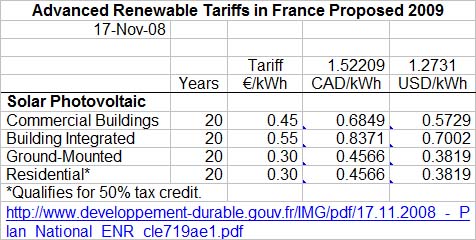France Raises Solar Feed-in Tariffs; New York SEIA Calls for FITs
The French Minister for Energy and the Environment announced last Monday that the government was launching an aggressive new program to propel the country to the forefront of solar energy development.
| Borloo said that France intends to become one of the world's leaders in the development of solar photovoltaic technology and will increase the supply of solar-generated electricity 400 times by 2020. |
The announcement by Minister Jean-Louis Borloo was made at the annual Grenelle meeting of French environmental stakeholders. Minister Borloo outlined 50 actions the Sarkozy government would take to substantially increase the role of renewable energy in France.
As part of its commitment to the European Union, Borloo said that France will supply 23% of its energy with renewables by 2020.
Most dramatically, Borloo said that France intends to become one of the world's leaders in the development of solar photovoltaic technology and will increase the supply of solar-generated electricity 400 times by 2020.
To do that, France will create a new tariff category for commercial buildings of €0.45/kWh (US $0.57/kWh). This is intended to aid businesses, factories and farmers to take profitable advantage of their large rooftops. As a measure of the government's seriousness, there will be no limit on the size of commercial rooftop projects that qualify for the tariff. For comparison, the French commercial tariff for 2009 is higher than that for Germany, the current world leader in solar PV development.
France has been a solar energy laggard in Europe. By mid 2008 there was only 18 megawatts (MW) of solar PV installed on the mainland. (France still maintains several overseas territories.) However, changes to the country's system of Advanced Renewable Tariffs (Tarife Equitable) in 2006 resulted in a flood of new projects. There is a huge backlog of some 12,000 systems representing 400 MW that are awaiting connection.
The government attributes the rapid growth to changes made to the tariffs for solar PV in 2006 when the government doubled the base feed-in tariff from €0.15 to €0.30 /kWh, the addition of another €0.25 /kWh for façade cladding and the inclusion of a 50% tax credit for residential installations.
The residential market accounts for 40% of French installations. The typical project is about 3 kW.
Even with the backlog, France's development of solar PV is well behind Germany, Spain and Italy and Borloo wants to change that.
The objective, Borloo said, is to install 5,400 megawatts (MW) by 2020, an increase of 400 times that of present installations.
There will be no change to the base tariff of €0.30/kWh ($0.38 USD/kWh) for ground-mounted projects and France continue the €0.55/kWh ($0.70 USD/kWh) tariff for building integrated systems.
Borloo suggested that France may also apply a feed-in tariff to concentrating solar power stations.

These tariffs will remain in effect until 2012 when they will be revisited as part of the normal review process.
To simplify interconnection of solar PV and reduce future backlogs with the quasi privatized state utility, Electricité de France, the government will implement an internet registration process for projects up to 450 kW.
Small solar PV systems less than 3 kW will also be exempted from certain taxes and fees as well.
Tariffs for wind energy will remain the same, though wind projects will have to undergo new siting requirements.
New York SEIA Calls for Feed-in Tariffs
In related feed-in tariff news, the
New York State's Solar
Energy Industries Association has called on the state to introduce
feed-in tariffs for solar photovoltaic systems. The recommendation by
NYSEIA is the third by a state solar industry association within the past
year. Previously, Florida SEIA and CalSEIA have also called for feed-in
tariffs.
The testimony by the solar association was filed with the
New York State
Public Service Commission (PSC) under the State's Administrative
Procedures Act (SAPA). The SAPA docket was on implementing the solar
portion of the state's Renewable Portfolio Standard (RPS).
The trade group called on the PSC to transform the state's current solar
rebate program to a "performance-based system known as a feed-in tariff
(FIT)." The feed-in tariff could solve many of the issues the SAPA hearing
was called to discuss, said NYSEIA. Most importantly, the association
continued, feed-in tariffs have been successful in Germany by allowing
banks to collateralize the payment stream, ensuring access to capital.
Specifically, the association said that the feed-in tariffs should be
implemented gradually rather than all at once. For example, consumers
could be offered a choice between the two programs, allowing the market
time to adjust.
There should be no project caps in the new program subject to the limits
of the interconnection, testified NYSEIA.
NYSEIA also called on the PSC to set a minimum solar PV target of 2,000 MW
and suggested that a target of 6,000 MW by 2020 could propel the state to
the forefront of solar development not only in the United States but the
world. The association argued that solar PV on just 0.5% of the land area
could provide all the electricity consumed in the state.
The association said that the rapid, large-scale development of solar PV
with feed-in tariffs would drive down the cost of utility service for all
customer classes while making the state a leader in job creation.
Unlike NYSEIA's emphasis only on solar,
FlaSEIA and
CalSEIA have both
proposed full systems of Advanced Renewable Tariffs that specify feed-in
tariffs for all forms of renewable energy. CalSEIA supported SB 1714,
which called for feed-in tariffs for renewable projects less than 20 MW in
size. It was ultimately withdrawn at the request of the sponsors just
prior to final passage.
 To subscribe or visit go to:
http://www.renewableenergyaccess.com
To subscribe or visit go to:
http://www.renewableenergyaccess.com